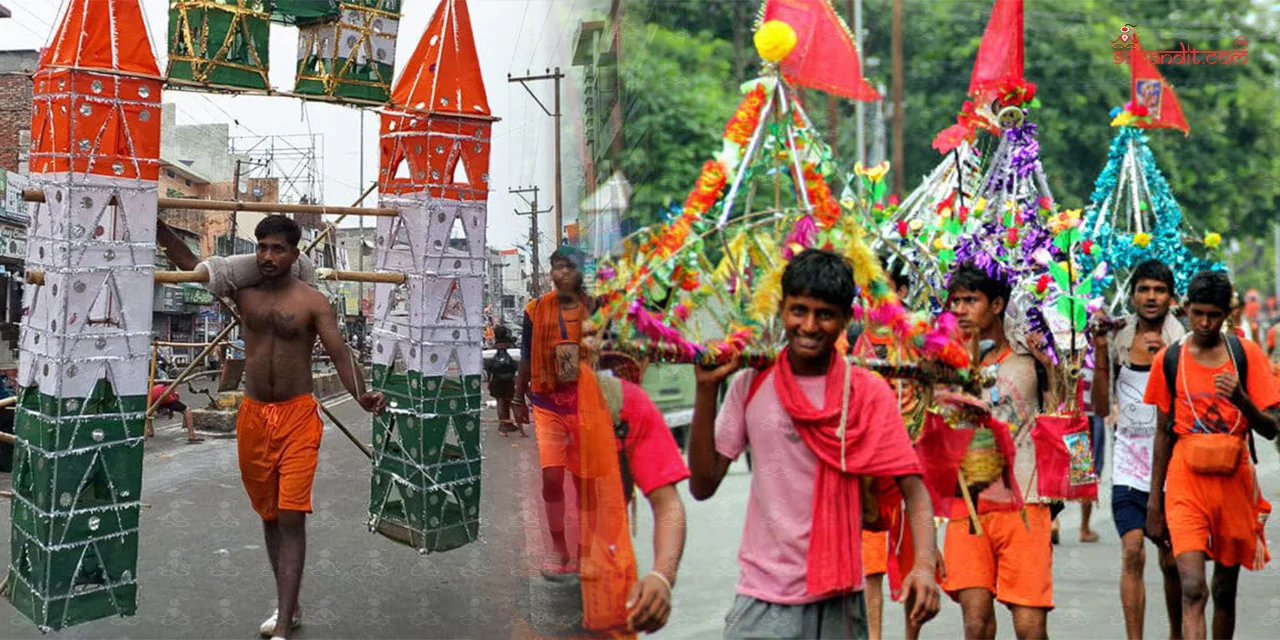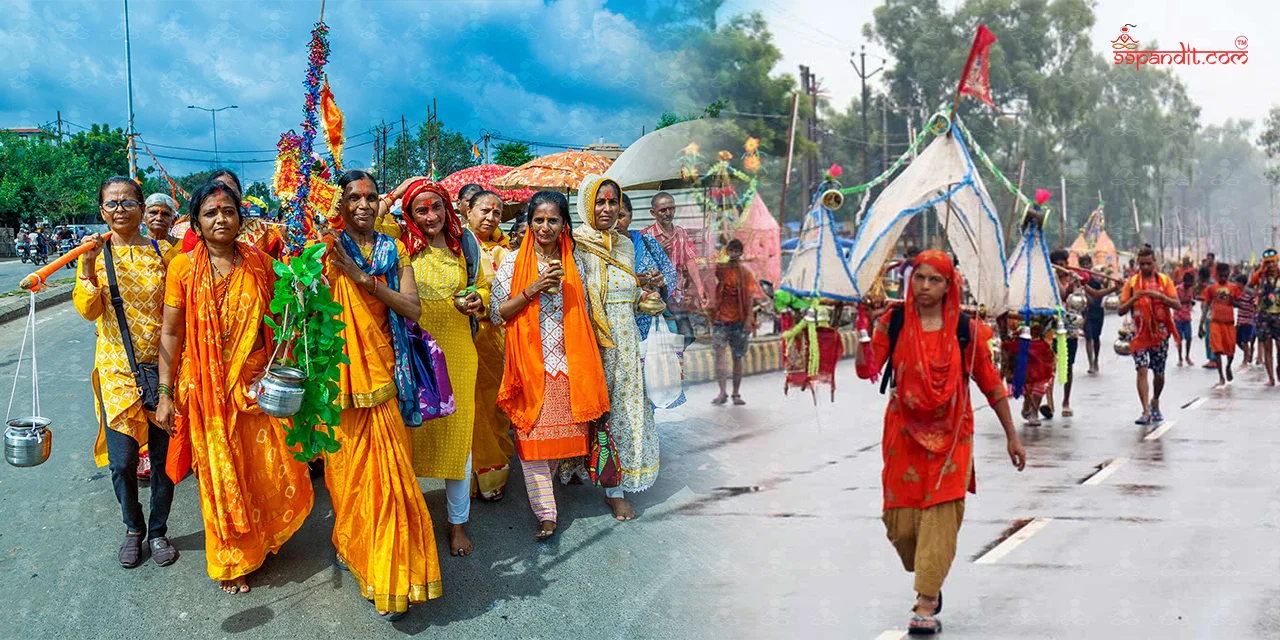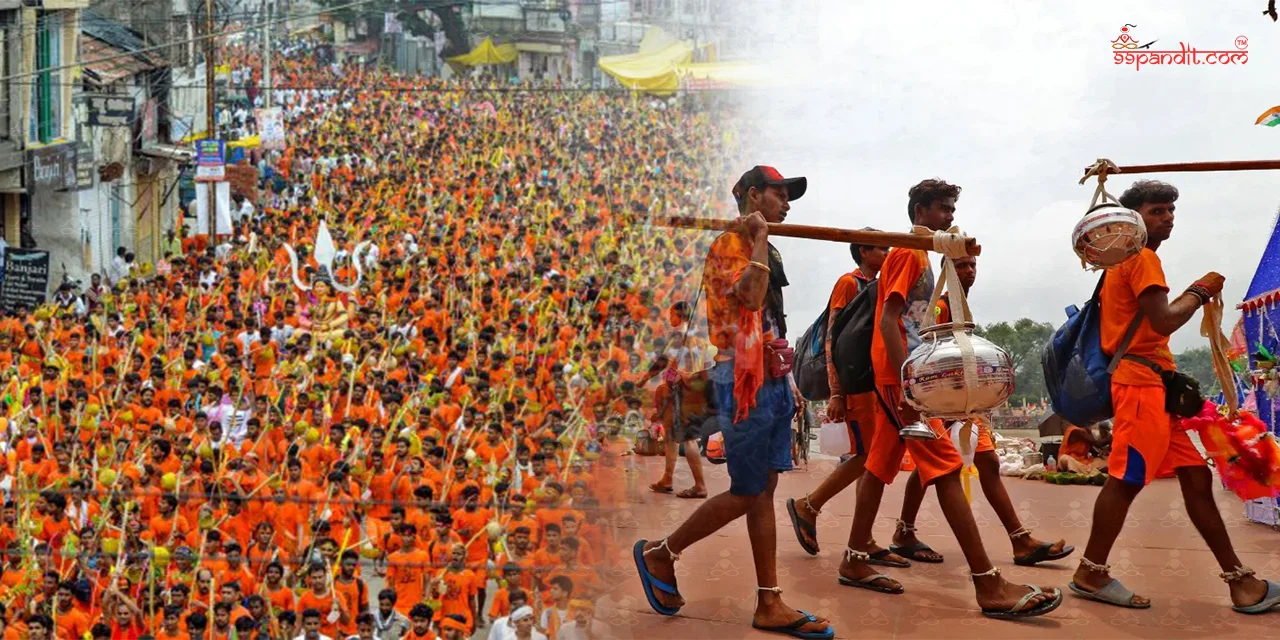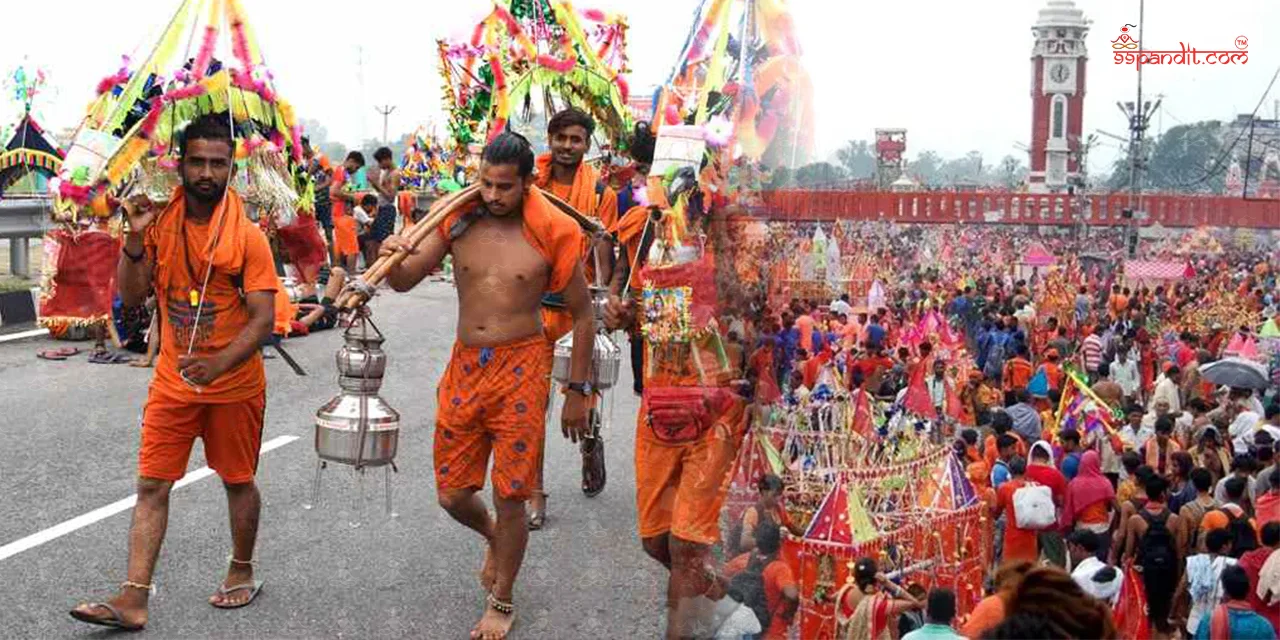Pausha Putrada Ekadashi 2025: 30 या 31 कब है पौष पुत्रदा एकादशी व्रत? जाने सही तिथि व मुहूर्त
पौष पुत्रदा एकादशी 2025: क्या आप जानते हैं कि साल 2025 अब धीरे-धीरे हमसे विदा ले रहा है? लेकिन जाते-जाते…
 0%
0%

Kawad Yatra 2025 is a sacred parade performed to honour lord bholenath by travelling a number of kilometres to his temple. This is performed during the holy month of Shravan by millions of devotees.
With barefoot dedication, saffron clothes, and chanting ‘Har har mahadev’, the auspicious ritual is a vibrant celebration of belief and surrender. The ritual is followed every year in the Sawan month.

In this yatra, ‘kanwariya’ means the people who carry kawad visit religious places like Haridwar and Uttarakhand to get water from the holy river Ganga.
The ritual is about offering sacred water to lord shiva on the festival of Sawan Shivratri.
Kawad yatra 2025 is starting from 11th July and will complete on 23rd July of Sawan Shivratri.
In this article, we’re going to tell you unknown and interesting facts about the Kawad Yatra. Hence, keep reading it!
The Kawad Yatra is a yearly sacred Hindu ritual performed by followers of Lord Shiva, especially in North India.
The word ‘kawad’ defines a special carrying appliance, basically a bamboo pole, with two equal loads filled with Ganga water broken from either end.
The pole is carried on a pilgrim’s shoulder. The simple meaning of ‘yatra’ is a journey or parade. Hence, the kawad yatra basically means the ‘journey with kawad’.
The basic ritual of this occasion is to bring sacred water ‘Gangajal’ from the Ganga river, mainly from Haridwar, Gaumukh, Ajgaibhinath, Gangotri, and Bhagalpur.
After that, the holy water is taken by worshippers to Shiva temples. The temples like Purva Mahadev Temple located in Baghpat and Augharnath temple in Meerut, Kashi Vishwanath Temple in Varanasi, Baidyanath Temple in Deoghar, along with Jyotirlingas, perform ‘Jalabhishek’.
A ritualistic offering made to the Shiva Linga. Hence, kawad yatra is not just a religious ceremony; it’s a huge spectacle of belief, resilience, and unity.
The way comes alive with a sea of saffron-clad followers, devotional songs, and resounding recitation of ‘Bol Bam!’
Hence, the insignificant scale of participation, with a group of devotees, makes it one of the biggest annual celebrations in the world.
The kawad yatra in 2025 will start on 11th July and will complete on 23rd July, 2025, or with the conclusion of last sawan Monday or Mahashivratri in Shravan.
It is done based on one’s pilgrim route and selected offering day. The Mondays of the Sawan month are thought especially sacred for offering worship to lord shiva.
The most certain day of this event, the Kawad Yatra Jal date of 2025, would be on 23rd July of Sawan Shivratri.
According to the Gregorian calendar, the processions mainly take place in the holy Hindu Sawan month, which falls in July and August.
The date for the yatra is found according Hindu lunar calendar, and particularly the Sawan month, which is devoted to lord shiva.
It’s essential to note that while the main period of procession is Shravan, few followers, certainly those undertaking the place to Baidyanath Dham from Sultanganj, might execute the parade throughout the year.
Though the grand scale and huge participation are mainly seen during the Sawan month.
Date: Wednesday, July 23, 2025
Chaturdashi Tithi:
Shivaratri Puja Timings:
Ratri Prahar Puja Timings:
In the holy month of Sawan, during Kawad Yatra, pilgrims undertake multiple forms of pilgrimage depending on their dedication, faith, physical strength, and devotion. These are the kawad yatra types:
Samanya Kawad (सामान्य कांवड़) –
A most common kawad yatra where followers walk or travel at a consistent pace with their kawad and bathe the Shiva ling with gangajal at temples.
Daak Kawad Yatra (डाक कांवड़) –
Worshippers run or walk back nonstop in a fast-paced yatra to offer the Gangajal. It’s thought to be highly tough and is usually completed within 1–2 days.
Kadhi Kawad (कड़ी कांवड़) –
The most strict form, where people do not keep their kawad on the ground at any cost – not even while resting or sleeping. It’s carried and kept upright every time.
Dandi Kawad (डंडी कांवड़) –
A strict kawad yatra where followers perform complete prostration (Sashtang dandvat) after each step. That makes it an extreme test of faith and physical strength.
The story of Kawad Yatra is mentioned in ancient Hindu scriptures. It’s considered that lord shiva drank the deadly Halahal poison during Samundra Manthan to protect the universe.
To rid him of the poison’s effects, people start offering Gangajal on the Shivalinga. The custom has evolved into what we now know as kawad yatra.

Kawad yatra is deeply rooted in multiple Hindu mythologies and sacred customs, making it a holy pilgrim site in historical and spiritual significance. Few of the stories will be described below to know its origin and enduring popularity.
This is possibly the most widely rooted mythological origin. According to the Puranas, during the ocean churning, a catastrophic event like ‘Halahal’ emerged before the holy nectar of Amrit.
The poison was so powerful that it risked destroying the entire universe. Hence, Lord Shiva consumed the Halal to protect the universe, keeping it in his throat, which seemed blue, called ‘Neelkanth’.
The poison generated immense burning and pain for Shiva. To reduce his pain, in Treta yug, the dedicated follower of Shiva, Lord Ram, is thought to bring holy water of Ganga jal by using a Kawad and pour it on Shiva’s temple in Puramahadev.
Thus, the Kawad yatra is known as a sacred way to honor the deity, where followers bring Gangajal to worship Lord Shiva, seeking blessings to remove suffering and express their devotion.
Another story is connected with legends that shows the initiation of kawad yatra to lord parshuram, who is the incarnation of lord vishnu.
It’s said that Parshuram carried gangajal from Garhmukteshwar to perform lord shiva’s abhishek at the Pura Mahadev temple in Baghpat, located in Uttar Pradesh.
The practice is believed to have further firmed the custom of carrying Gangajal for honoring Shiva.
The legend states that Shravan Kumar brought his parents in a kawad on a pilgrimage, which included a visit to Haridwar, where he helped them bathe in the Ganges.
The selfless practice of filial piety and place is considered holy by some as an early predecessor to the kawad yatra.
Historically, this yatra was more localized and hence a less organized pilgrimage, especially undertaken by sages and ascetics.
Passing the time, it achieved immense popularity among other followers, mainly in North India.
The simplicity of profound mythological ritual and its connections, or the faith in Lord Shiva’s benevolent behaviour, has converted it into a huge annual occasion.
The kawad yatra 2025 routes are a lot in number, with people selecting their way depending on their geographical location, the particular Shiva temple they need to visit after carrying the holy water, and the distance they can travel.
The starting points are often holy places where the river flows, enabling followers to gather the sacred water.

For a lot of people, knowing the right kawad yatra route is important for scheduling the pilgrimage.
The rituals of the kawad yatra are characterized by many practices that show the devotion, discipline, and religious intent of the pilgrims.
The practice of the kawad yatra journey begins with collecting Ganga water, which is the basic ritual of this event.
Devotees gather water on the Jal date of Kawad Yatra with faith, usually offering prayers and taking dips in the sacred river.
The central practice of the event is to collect water that is carried into two containers, managed on either side of a bamboo pole.
The pilgrim then carries the kawad on their shoulder. The process of carrying the kawad is symbolically:
Most of the custom kanwariyas undertake the yatra barefoot without wearing any footwear.
It shows humility, penance, and a disconnection from material luxury, a process highly connected with its history.
The saffron colored dress shows purity, sacrifice, and spiritual awakening. It even creates a powerful visual identity for the followers, boosting a sense of solidarity and shared goal.
During the journey, the air resonates with devotional songs and chanting of ‘Bol Bam’, ‘Har har mahadev’, and other Shiva mantras.
Chanting not just keeps the pilgrims encouraged but also creates an effective, powerful, electrifying religious atmosphere along the kawad yatra journey.
The pilgrims follow strict rules and discipline during the journey:
Fasting: A Lot of people observe a fast, refraining from specific foods, alcohol, and other drinks.
Celibacy: Worshippers manage asceticism in the kawad yatra.
Purity: They intend to handle a high level of physical and mental purity.
Silence: Few people keep periods of silence as a practice of self-control and introspection.
No Personal Grooming: Some of them do not shave or cut their hair during the journey.
The community widely supports this remarkable part of the journey. There are multiple voluntary communities along the routes, local groups, and one set up ‘Kawad camps’, or ‘Sewa shivir’. The camps offer:
Free Food and Water: Providing pilgrims with enough food and water to ensure nourishment and hydration.
Medical Aid: Managing blisters, fatigue, and other health issues.
Resting Facilities: Showing temporary shelters and stands for Kanwars.
Security: Local authorities also give significant forces to handle traffic and ensure the safety of the pilgrims. This joint “seva” illustrates the spirit of selfless service and charity.
The completion of the Kawad Yatra ends with ‘Jalabhishek’, the ritualistic process of bathing the holy Shiva linga with Ganga jal at selected destinations.
The offering, usually organized during the yatra, is considered to remove sins, achieve wishes, and bring blessings from lord shiva.
People particularly perform the ritual on a Monday of Shravan, which they consider powerful for worshipping the deity.
At the time of the Kawad Yatra 2025, Kanwariyas will offer Ganga jal to the following specific Shiva temples:
Nilkanth Mahadev Temple, Rishikesh: This is the place where lord shiva consumed poison during the ocean churning and has a rough landscape with floating waters. It’s located 49 km from Haridwar.

Baba Baidyanath Dham, Deoghar: A sacred jyotirlinga and a popular place for kawad yatra for kanwariyas. The yatra begins with over 100 km of walking barefoot.
Kashi Vishwanath Temple, Varanasi: The temple is situated by the Ganga river. Being a part of yatra for eastern uttar pradesh.
Shri Kashi Vishwanath Temple, Mathura: This is essential for pilgrims, especially those from Braj.
Meeting of local people to collect water at Haridwar and carry it to the local temple for offering or puja.
Before You Go:
During the Yatra:
Safety Precautions:
At 99Pandit, we recognize the importance of kawad yatra and our commitment to supporting your spiritual journey.
We deliver a curated selection of required items and solutions catered to improve the pilgrimage experience, enabling you to focus on your devotion and association with the divine.
For example, you can book a pandit for Durga Puja, marriage puja, Hanuman Chalisa jaap, and a sundarkath path puja kit.
Entire kawad yatra kit: Facilitate the preparation of your kawad journey with our organized kits, which include every required puja item.
The kits may include pure copper kalash for gathering gangajal, saffron clothing, and high-quality rudraksha malas.
Get complete items for the sacred ritual, pure copper vessel, puja thalis, bilva patra, and other required items for jalabhishek.
Easy Ordering: Place your puja samagri order at shop.99Pandit or call us, WhatsApp your needs. We provide pan-India delivery for your ease.
Quality Assurance: We appreciate quality and authenticity. The team creates each item using verified materials and carefully packages it to ensure safe transport.
We deliver products from trusted suppliers, ensuring the highest quality and craftsmanship.
The Kawa Yatra 2025 is a sacred event of covering kilometres to visit the lord shiva temple and worship him with sacred water, Gangajal.
The kawad yatra is a holy pilgrimage across India that converts national highways and old-age pathways into holy arteries of devotion.
It spans centuries, a testament to show dedication in lord shiva’s benevolence and the cleansing power of the holy Ganges.
The event is a living custom that follows while retaining its base, recalling the enduring strength of belief, the significance of spiritual discipline, and the power received from shared devotion.

100% FREE CALL TO DECIDE DATE(MUHURAT)

Table Of Content
Filters by categories
All Pujas
Puja On Special Events
Upcoming Pujas
Dosha Nivaran Pujas
Mukti Karmas
Filters by Trending Topics
Filters by Regions
North Indian Pujas
South Indian Pujas